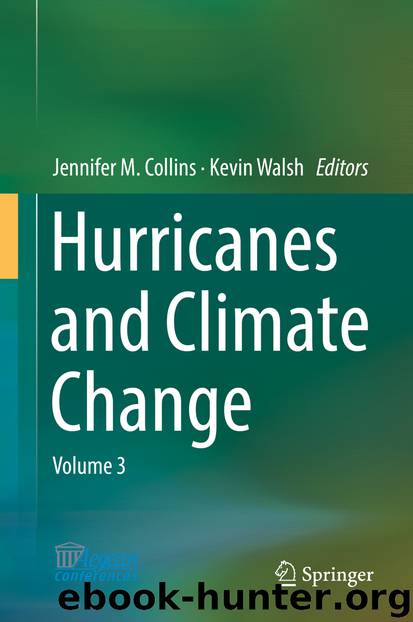Hurricanes and Climate Change by Jennifer M. Collins & Kevin Walsh

Author:Jennifer M. Collins & Kevin Walsh
Language: eng
Format: epub
Publisher: Springer International Publishing, Cham
2.1 One-Dimensional Model Studies
Previous work has suggested that TCMIs are unique to Australia because of the ability of sandy soil to rapidly release huge amounts of energy when moistened (Emanuel et al. 2008). Andersen et al. (2013), however, sought to simulate the soil profiles of four major TC intensification regions. Energy flux values leading up to four TCMI events, one in each region, were generated to assess the feasibility of the Brown Ocean concept. The analysis was performed using the HYDRUS-1D numerical water and heat flow model and MERRA atmospheric data. Andersen et al. (2013) determined the trends and magnitudes of the surface energy fluxes before a cyclone entered the intensification region and compared the simulated energy flux values to observed values over the tropical ocean. In their analysis, the soil temperature and heat fluxes from the model runs were used to assess the surface conditions prior to the tropical cyclone. In southeastern China, northern Australia, and central India, the temperatures decreased slightly with time, while soil temperatures in the south-central USA increased. The USA and Australia had the greatest diurnal fluctuations and highest maximum temperatures, possibly due to high solar radiation during the day and radiational cooling at night.
In the regions where intensification was to occur, the LHF was highest in the afternoons/evenings and lowest in the mornings. As solar radiation warmed the boundary layer throughout the day, evaporation increased along with the LHF. The LHF values were consistently higher in China and India. In the USA and Australia, the LHF trend closely followed the precipitation trend due to the overall drier conditions. The daily maximums for all regions often reach 200 W m−2. The soil texture did not appear to have a significant effect on the LHF magnitudes across regions; however, the diurnal changes were sharper over Australia (Andersen and Shepherd 2013; Andersen et al. 2013).
LHFs within TCs are not precisely known due to the lack of accurate observations. However, remote sensing observations and algorithms have been used to calculate reasonable estimates (Guimond et al. 2011). According to Zhang and Rossow (1997), the mean annual LHF peaks around 115–125 W m−2 near 15°N/S. Trenberth and Fasullo (2007) estimate that the typical LHF over the tropical ocean is approximately 120 W m−2. Satellite-derived LHF estimates of the pre-TC ocean environment are approximately 100–200 W m−2 (Liu et al. 2011). In the western North Pacific, TC LHF maxima have been estimated as 150–190 W m−2 (Gao and Chiu 2010). According to the Andersen et al. (2013) HYDRUS study, daytime LHF values over the study regions of southeastern China, south-central USA, northern Australia, and central India easily exceed these estimates.
Compared with observations, HYDRUS underestimated the pre-storm maximum LHF values (up to 140 W m−2 in Australia). Despite this bias, the HYDRUS inland fluxes were remarkably higher than the ocean fluxes (>200 %) in China and India. In the USA and Australia, the land and ocean fluxes were nearly equal. The results indicated that just before the passage of a cyclone, the land surface is capable of producing a daytime LHF magnitude that is comparable to that over the ocean.
Download
This site does not store any files on its server. We only index and link to content provided by other sites. Please contact the content providers to delete copyright contents if any and email us, we'll remove relevant links or contents immediately.
Man-made Catastrophes and Risk Information Concealment by Dmitry Chernov & Didier Sornette(5659)
The Revenge of Geography: What the Map Tells Us About Coming Conflicts and the Battle Against Fate by Kaplan Robert D(3964)
Zero Waste Home by Bea Johnson(3659)
In a Sunburned Country by Bill Bryson(3374)
COSMOS by Carl Sagan(3353)
Good by S. Walden(3353)
The Fate of Rome: Climate, Disease, and the End of an Empire (The Princeton History of the Ancient World) by Kyle Harper(2878)
Camino Island by John Grisham(2722)
A Wilder Time by William E. Glassley(2693)
Organic Mushroom Farming and Mycoremediation by Tradd Cotter(2568)
The Ogre by Doug Scott(2506)
Human Dynamics Research in Smart and Connected Communities by Shih-Lung Shaw & Daniel Sui(2432)
Energy Myths and Realities by Vaclav Smil(2384)
The Traveler's Gift by Andy Andrews(2304)
9781803241661-PYTHON FOR ARCGIS PRO by Unknown(2272)
Inside the Middle East by Avi Melamed(2233)
Birds of New Guinea by Pratt Thane K.; Beehler Bruce M.; Anderton John C(2179)
A History of Warfare by John Keegan(2107)
Ultimate Navigation Manual by Lyle Brotherton(2055)
